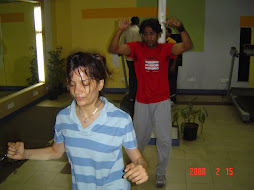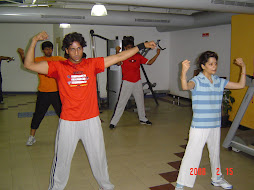
Q&A with Reema Sarin, Fitness Consultant, BOLLYWOOD AEROBICS PROGRAM, www.reemafitness.com; Cell No. 984 964 7772
Q Is it good what websites are doing (urging teenagers to starve)?
“This is not good at all. Yes, there are many internet sites that are ‘promoting starvation’ as short-cuts methods to effective weight loss, which is extremely dangerous as it can lead to serious eating disorder called ‘anorexia’. Anorexia is an eating disorder where people starve themselves. It usually begins in young people around the onset of puberty. Individuals suffering from anorexia have extreme weight loss, usually 15% below the person's normal body weight. People suffering from anorexia are very skinny but are convinced that they are overweight. Weight loss is obtained by many ways like by doing excessive exercise, intake of laxatives and not eating. Anorexics (mainly affects adolescent girls) have an intense fear of becoming fat. Their dieting habits develop from this fear.
People with anorexia continue to think they are overweight even after they become extremely thin, are very ill or near death. Often they will develop strange eating habits such as refusing to eat in front of other people. The disorder is thought to be most common among people of higher socioeconomic classes and people involved in activities where thinness is especially looked upon.
Some of the ill-effects of Anorexia or ‘starvation diets’ include:
Body mass index less than 17.5 in adults, or 85% of expected weight in children; Stunted growth; Endocrine disorder, leading to cessation of periods in girls; Decreased libido; impotence in males; Reduced metabolism, slow heart rate, hypertension and anemia; Thinning of the hair; Constantly feeling ‘cold’; Zinc deficiency; Reduced immune system function; Pallid complexion and sunken eyes; Tooth decay; Constipation; Dry skin; Headaches, amongst others.
Some emotional ‘ill-effects’ include:
Low self-esteem; Intense fear about becoming overweight; Mood swings; Deterioration in relationships with the family; Excessive exercise, food restriction; Secretive about eating or exercise behavior, suicide attempts, amongst others.
Hence, internet sites promoting starvation can have fatal repercussions and hence are proving to be extremely harmful.
Q What are the various ways by which a teenager can become fit without starving to death?
First of all, there is absolutely no connection in being ‘fit’ and ‘starving to death’. As described above, people who go on starvation diets are far from being healthy or ‘fit’, and instead, they are extremely weak with all sorts of muscular and basic body ailments and deficiencies.
To keep ‘fit’, teenagers need to do to keep ‘fit’ is to:
a) Follow a moderate exercise routine – any type of ‘aerobic’ or cardio workout 3 – 4 times a week. For e.g Swimming, jogging, power walking, aerobics, cycling, etc
b) Supplement the above cardio exercise with ‘body conditioning’ and strength training exercises like ‘calesthenics’, light weight training, etc
c) Have a well balanced healthy diet, with intake of normal meals everyday. Recommendations here to have a high protein diet, with moderate carbohydrate and low fat and sugar intake. Vegetables, fruits (for natural sugar), cereals, ‘white meats’ like chicken and fish, eggs, lentils, dairy like milk and yoghurt.
d) Adequate regular sleep patterns – 7 hours minimum daily
e) As much as possible, avoid intake of alcohol, high caffeine (tea and coffee) and stamina killing consumes like cigarettes, drugs etc.
f) Healthy mind leads to a healthy body, so indulge in relaxation giving activities like mediation, listening to soft music, deep breathing and YOGA exercises atleast thrice a week.
g) Last but certainly not the least – drink atleast 8 glasses of water a day.
Q Can you elaborate on some exercises to be fit?
1. A complete fitness program must include aerobic exercise, muscular strength and endurance conditioning, and flexibility exercise. Aerobic exercise does good things for your cardiovascular system and is an important part of weight management. Muscular conditioning can improve strength and posture, reduce the risk of lower back injury, and is also an important component of a weight management program. Flexibility exercise is needed to maintain joint range of motion and reduce the risk of injury and muscle soreness.
2. Walking is a weight-bearing aerobic exercise. So are jogging, rope skipping and dance-exercise. Aerobic exercise is any activity that uses large muscle groups in a continuous, rhythmic fashion for sustained periods of time. There are also non-weight-bearing aerobic exercises, such as bicycling, stationary cycling, swimming and rowing.
3. Keep the pace comfortable. A very important aspect of your exercise program is the intensity. You should exercise at a comfortable pace. You can measure your exercise heart rate to check the intensity of your exercising, or you can take the 'talk test.'
To measure your heart rate, take your pulse as soon as you stop exercising. Count your heartbeat for 10 seconds, then multiply that by six to convert it to a one-minute heart rate. If you keep your exercise heart rate within a range of 55 percent to 80 percent of an estimated maximum heart rate (220 minus your age), you're doing well.
4. How long should you exercise? Work up to 20 or more minutes per session for general health maintenance. For weight loss, gradually work up to 45 minutes or longer at low to moderate intensities in a low- or no-impact activity.
5. Strength conditioning gives you a choice. Pick calisthenics, free weights or machines. Just be sure that your strength training includes exercises for every major muscle group, including the muscles of the arms, chest, back, stomach, hips and legs.
Start with a weight that's comfortable to handle and keep it up for eight repetitions. Gradually add more repetitions until you can complete 12 repetitions. For greater strength conditioning, add more weight and/or more repetitions, in sets of eight to 12, when the exercise becomes easy. 6. Stretch for flexibility. Proper stretching involves holding a mild stretch of 10 to 30 seconds while you breathe normally. Always warm up before you stretch. Like strength conditioning, flexibility exercises should include stretching for all the major muscle groups.






No comments:
Post a Comment